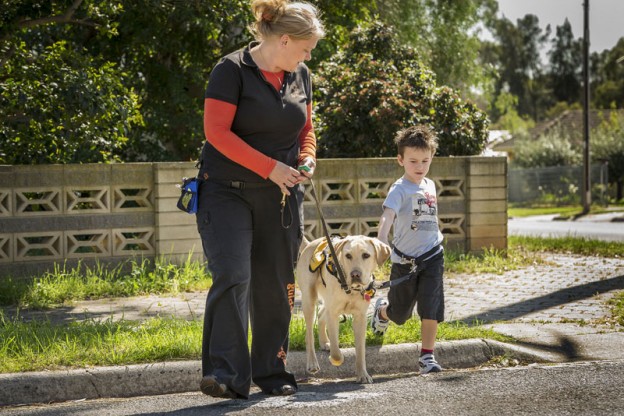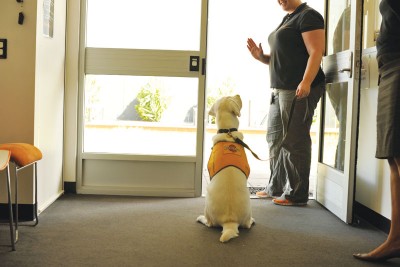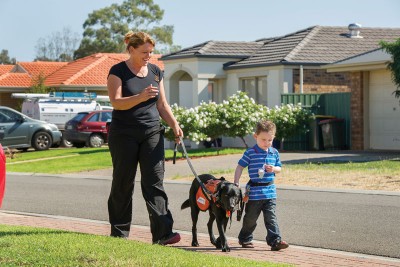
Whether working on a farm or providing vital assistance to people living with special needs, recent studies have shown that the key to a working dog’s success is a positive environment, writes Kate Potter.
According to a new study of farm dogs from the University of Sydney’s Faculty of Veterinary Science, dogs provided with kinder training methods and good living conditions are showing the best results in the workplace. Findings from the study show that handlers who use positive reinforcement with their dogs, including food rewards, verbal praise, physical contact and play, report greater success with their training than those who use tools such as electric-shock collars.
The study also identified associations between success and a number of factors such as dog breed, age training started and the personality traits of the owner.
Although the study focuses on farm dogs, the insights also have potential relevance to companion dogs and those working in other contexts.
Using positive reinforcement

Susan Clark, principal guide dog mobility instructor at Guide Dogs SA/NT, agrees that the outcomes of the farm dog study can be seen in the systems and training used with the assistance dogs she works with.
“We work with positive reinforcement to encourage our dogs to think for themselves. The skill of the instructor is in knowing how to help shape their thinking, because it’s not the same for every dog.
“If you can create a ‘thinking dog’ that learns the behaviours you’re looking for, [the training] simply becomes innate. You see dogs that really enjoy what they’re doing — they’re happy dogs working for the off chance that they’ll get praised,” Clark says.
A deep bond

Professor Paul McGreevy from University of Sydney explains that while the breed can be an important factor for the success of a working dog — Cattle Dogs and Kelpies were strong performers in the study — the nature of the handler and the relationship between them and the dog also has a strong impact on the dog’s performance outcomes.
“The role of conscientiousness in handlers is particularly interesting as it is relevant to the best handling and training methods,” McGreevy says. “We know that good animal training is underpinned by consistency and timing.”
This means that handlers who are consistent, give clear commands, and are timely with their positive reinforcement allow their dogs to make the strongest association between how they are behaving and the appearance of rewards.
At Guide Dogs SA/NT, trainers use games and grooming sessions to develop a bond of trust with the dogs, and then use clicker training to encourage their learning.
Clark explains that persistence and appropriate rewards are vital for training assistance dogs.
“We try to encourage the dogs to think for themselves during clicker training. The dogs soon learn that when they do something the trainers approve of, they’ll receive a reward.
“We reward on a random basis. The dog doesn’t get a bit of kibble every time it does something. Because they never know when the reward is going to happen, they’ll keep going until they get it.”
Being patient as a dog learns is critical because when a dog loses its confidence, its training can dissipate rapidly.
“Some dogs just get it straight away and enjoy the idea of discovering what behaviours will earn them a reward, whereas others may take a couple of weeks,” says Clark.
“The important thing is to let the dog work it out in its own time, as we’ve found this method of training means the dog is more confident.”
Home sweet home
When it comes to living conditions, discussions in the farm dog study suggest that a dog’s housing or living environment is likely to have significant impact on its performance.
Clark says that including the “pet dog” experience as part of an assistance dog’s training is an important part of understanding their temperament and suitability for their future role.
“If a dog is kenneled, you don’t get to see if it has any bad at-home behaviours or if it has the ability to relax and just chill out when it’s not working and throw off what’s happened during the day.”
“When the dogs are with us in the training centre, they’re workers but when they go home to their boarding families at the end of the day, they can relax and be a pet dog,” says Clark.
In a farm-work context, it appears that dogs that are housed with other dogs and given the opportunity to play and socialise are well-rested and well-adjusted working dogs that perform better in their workplace than dogs that are tethered or kept in solitary kennels when off-duty.
While an in-home environment may meet a dog’s need for comfort and human socialisation, the farm dog study raises the concern that this living arrangement may present a training-related disadvantage. Out of work periods, where trained responses are not required, isolating the dog from the handler can reduce generalisation, where the dog gives a trained response to cues similar to those used in training.
Make training easier with help from the professionals - on our DOGSLife Directory now!



